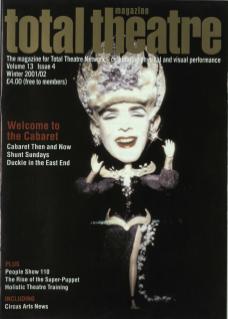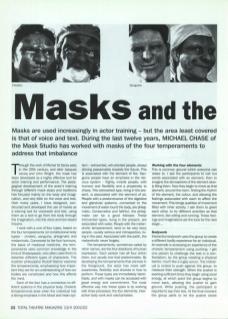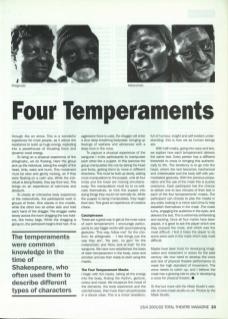Through the work of Michel St Denis early in the 20th century, and later Jacques Lecoq and John Wright, the mask has been developed as a highly effective tool for actor training and performance. The pedagogical development of the actor's training through different mask styles and traditions has focused mainly on the body and imagination, and very little on the voice and text. Over many years, I have designed, constructed and developed the use of masks as a training tool for voicework and text, using them as a tool to go from the body through the imagination, into the voice and text-based theatre.
I work with a unit of four types, based on the four temperaments (or constitutional body types) – choleric, sanguine, phlegmatic and melancholic. Connected to the four humours, the basis of medieval medicine, the temperaments were common knowledge in the time of Shakespeare, who often used them to describe different types of characters. The Austrian philosopher Rudolf Steiner explored the temperaments, emphasising how important they are for an understanding of how our bodies are constituted and how this affects the mind.
Each of the four has a connection to different systems in the physical body. Choleric temperaments arise when the individual has a strong emphasis in the blood and heart system – extroverted, will-oriented people, always striving passionately towards the future. This is associated with the element of fire. Sanguine people have an emphasis in the nervous system – flighty, mobile people, with humour and flexibility and a propensity to chaos. This extroverted type, living in the present, is associated with the element of air. People with a predominance of the digestive and glandular systems, connected to the movement of water round the body, are phlegmatic. Conservative and faithful, the phlegmatic can be a good follower. These introverted types, living in the present, are associated with water. People with the melancholic temperament, tend to be very bony people, usually serious and introspective, living in the past. Associated with the earth, the melancholic never forgets.
The temperaments were common knowledge in the time of Shakespeare, who often used them to describe different types of characters.
The temperaments, sometimes called by other names, are the four directions of human expression. Each person has all four within them, but usually one that predominates. By developing the temperaments that are less in the foreground, the actor has more self-awareness, flexibility and choices in how to perform. These types are immediately identifiable, and with masks can be accessed with great energy and commitment. The most effective way into these types is by working with three processes: the four elements, interactive body work and catchphrases.
Working with the four elements
This is common ground which everyone can relate to. I ask the participants to call out words associated with an element, then to imagine the atmosphere of the element slowly filling them. Now they begin to move as that element, around the room, finding the rhythm of the element, the colour, and allowing the feelings associated with each to affect the movement. This brings qualities of movement filled with inner activity. I ask them to greet each other, to try different activities as that element, like sitting and running. These feelings and imaginations set the tone for the next stage...
Bodywork
Interactive bodywork uses the group to create a different bodily experience for an individual. An example is accessing an experience of the choleric temperament using pushing. I get one person to challenge the rest in a confrontation, by the group creating a physical barrier, much like a rugby scrum. The individual is invited to push against the group, to measure their strength. When the pusher is exerting sufficient force they begin using vocal energy, at which point the group begins to move back, allowing the pusher to gain ground. While pushing, the participant is required to say their text. At the final moment the group parts to let the pusher shoot through like an arrow. This is a wonderful experience for most people, as it allows the resistance to build up huge energy, exploding into a powerhouse of thrusting force and dynamic vocal energy.
To bring on a physical experience of the phlegmatic, we do floating. Here the group pick up the individual, taking the weight of the head, limb, waist and trunk. This movement must be slow and gently rocking, as if they were floating on a calm sea. While the individual is being floated, they say their text. This brings on an experience of calmness and pleasure.
To create an interactive body experience of the melancholic, the participants work in groups of three. One stands in the middle, while the other two sit either side and hold each hand of the dragger. The dragger walks slowly across the room dragging the two holders, like heavy bags. While the dragging is going on, the participant begins their text. If no aggressive force is used, the dragger will enter a slow deep breathing body-state, bringing up feelings of sadness and aloneness with a deep tone in the voice.
To capture a physical experience of the sanguine I invite participants to manipulate each other like a puppet. In this exercise the group manipulates the one by taking the head and limbs, getting them to move in different directions. This must be built up slowly, adding more manipulators to the puppet, until all four limbs and the head are moving simultaneously. The manipulators must try to coordinate themselves, to trick the puppet into doing things they would not normally do. While the puppet is being manipulated, they begin their text. This gives an experience of creative chaos.
Catchphrases
These are a great way to get at the inner voice of each temperament. I encourage participants to use trigger words with accompanying gestures: 'This way, follow me!' for the choleric; for phlegmatic – 'I like things just the way they are'; 'No pain, no gain’ for the melancholic; and ‘Wow, look at that!' for the sanguine. We have now established the basis of each temperament in the body, voice and emotion and are then ready to start using the masks.
The Four Temperament Masks
I begin with full masks, taking all the energy into the body, finding the rhythm, gesture, colour and mood. We recapture the mood of the elements, the body experience and the catchphrases, then have them all participate in a dance class. This is a minor revelation, full of humour, insight and self-evident understanding: this is how we as human beings are.
With half-masks, going into voice and text, we explore how each temperament delivers the same text. Every person has a different threshold to cross in bringing this authentically to life. The tendency is to go into the head, where the text becomes mechanical and unbelievable and the body stiff with premeditated gestures. With the previous preparation and the use of the mask this is quickly overcome. Each participant has the chance to deliver one to two minutes of their text in each of the four temperaments' masks. The participant can choose to play the masks in any order, looking in a mirror each time to help establish themselves in the mask. The mask turns, engaging the audience in the eyes, and delivers the text. This is extremely exhilarating and exciting. Once all four masks have been played, it is good to ask the player which one they enjoyed the most, and which was the most difficult. I find it helps the player to do some extra work in the mask which was most difficult.
Masks have been tools for developing imagination and movement in actors for the past century. We now need to develop the voice and text of physical theatre performance to meet the high standard of movement. The voice needs to catch up, and I believe the mask has a growing role to play in developing a voice for physical theatre.
To find out more visit the Mask Studio's website at www.mask-studio.co.uk


